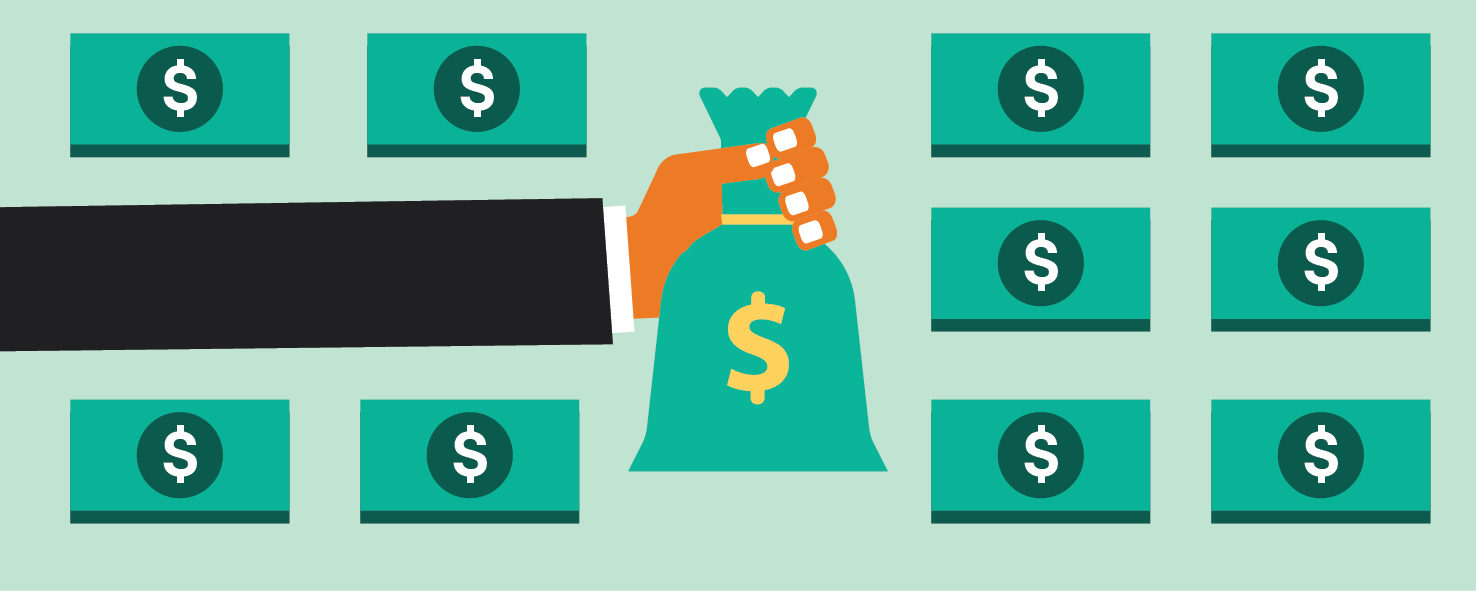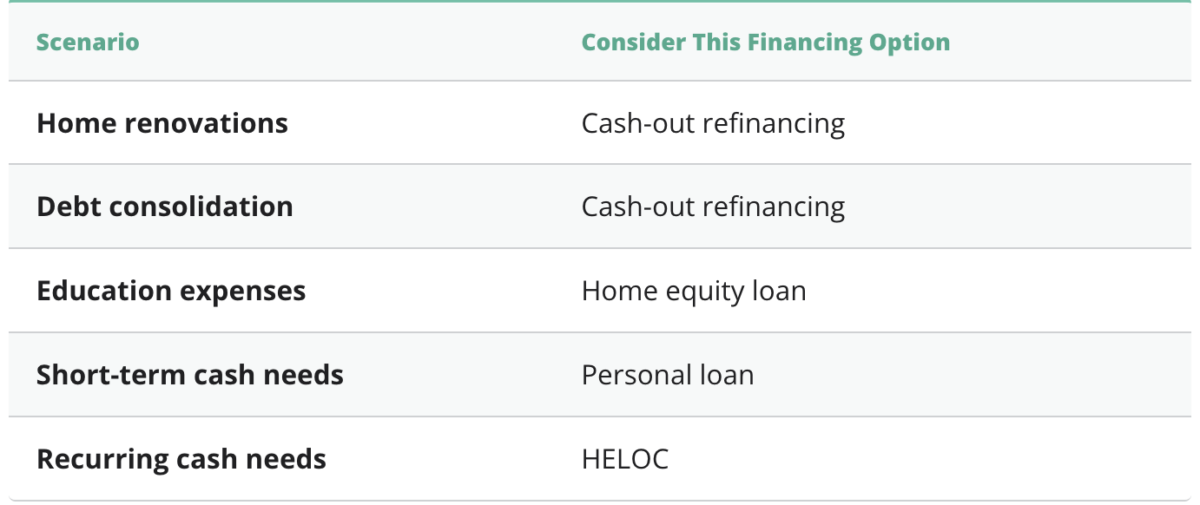Our goal is to give you the tools and confidence you need to improve your finances. Although we receive compensation from our partner lenders, whom we will always identify, all opinions are our own. Credible Operations, Inc. NMLS # 1681276, is referred to here as "Credible."

Credible Operations, Inc. NMLS# 1681276, “Credible.” Not available in all states. www.nmlsconsumeraccess.org.
This article first appeared on the Credible blog.
If you need money for home improvements, paying down debt, or financing other major expenses, you could consider tapping into your home’s equity with a cash-out refinance.
With a cash-out refinance, your existing mortgage is paid off and replaced by a new loan with a higher loan amount than what you owe on your home. You get the extra amount, minus any closing costs, as a lump sum payment to use as you wish.
Here’s what you should know about cash-out refinancing:
What is a cash-out refinance?
Cash-out refinancing lets you use the equity in your home (the difference between how much your home is worth and how much you owe on your existing mortgage) to take out a larger mortgage.
The new mortgage pays off your old mortgage, then you get the difference between the two, minus closing costs, as cash. Like traditional mortgage refinancing, your new loan will most likely have different terms than your old one.
With Credible, you can compare mortgage refinance rates from various lenders, all in one place.
How does a cash-out refinance work?
Here’s an example of what a cash-out refinance looks like:
Example: Let’s say you have a mortgage balance of $150,000 and your home value is $250,000. Most lenders will only allow you to borrow 80% of your home’s value — in this case, you’d be able to tap up to $50,000 in equity for a maximum loan balance of $200,000. Now, say you wanted to take out $10,000 in equity to replace your roof. With a cash-out refinance, that amount would be applied to your new mortgage’s principal balance. So, in the end, you’d take out a mortgage worth $160,000 — $150,000 to pay off your original mortgage and $10,000 in cash to cover the cost of the roof.
If you decide that cash-out refinancing is right for you, be sure to consider as many lenders as possible to find the best deal.
Cash-out refinance rates
Today’s cash-out refinance rates are still near historic lows. However, these rates can be as much as 0.5% higher than a traditional mortgage refinance since you’re tapping your home equity.
Several factors impact your cash-out refi rate, such as:
- Credit score: A higher credit score can help you qualify for a lower mortgage rate.
- Loan-to-value ratio (LTV): A lower LTV ratio can reduce your rate if you don’t access all of your available home equity since you’re borrowing less.
- Repayment term: Longer repayment lengths have a higher interest rate but a lower monthly payment.
- Closing costs: Your lender may allow you to roll your closing costs into the loan. Unfortunately, this choice increases your APR and total amortization.
- Debt-to-income ratio (DTI): A higher DTI poses more risk and a lender may not approve your application. Strive to have a DTI ratio of 36% or less before you apply with a conventional mortgage lender.
With a cash-out refinance, you’ll pay the same interest rate on your existing mortgage principal and the lump-sum equity payment. Most lenders offer fixed interest rates so you can easily calculate your monthly payment.
Pros of cash-out refinancing
Here are the advantages of a cash-out refinance:
- Low interest rate: Cash-out refinances have lower interest rates than credit cards or personal loans, which can make them a cost-effective option for financing projects like home renovations.
- Larger loan amount: Depending on how much equity you have in your home, you might be able to get a larger amount of cash than you could with alternatives like a personal loan.
- Savings on high-interest debt: If you use cash-out refinancing to consolidate high-interest debt (like credit card debt), you can pay off your balances sooner and possibly save thousands of dollars thanks to a lower interest rate.
- Longer repayment term: Because a cash-out refinance is essentially a new mortgage, you’ll have 15 to 30 years to repay it. With a longer repayment term, you’ll have more affordable monthly payments than you would with a credit card or personal loan, which usually have shorter terms.
Cons of cash-out refinancing
Before you apply for a cash-out refinance, it’s vital to weigh the potential disadvantages:
- Foreclosure risk: Your home serves as collateral with cash-out refinancing. If you fall behind on your loan payments, the bank can foreclose on your house, meaning you could lose your home.
- Closing costs and fees: Just like when you bought your home, you’ll have to pay closing costs and fees. This includes appraisal fees, credit report fees, and title fees, adding thousands of dollars to your loan costs. You might be able to roll these costs into your loan amount, but keep in mind that you could end up paying more in interest this way.
- Lengthy application and approval process: When you apply for cash-out refinancing, you’ll have to go through the mortgage approval process. This can take several days or even weeks, so if you need the money right away, you might be better off with another financing option.
- Lending requirements: To qualify for cash-out refinancing, you’ll have to meet the lender’s mortgage requirements. This includes having a debt-to-income ratio of 50% or less, plus a sizable amount of equity in your home. You’ll also need fair to good credit — usually a score of at least 620, but ideally 700 or higher. Start building credit before applying for a refinance to increase your chances of qualifying.
Take the time to shop around and compare lenders to find the right cash-out refinance loan for you. Credible can help you do this — it’s free, and you don’t even have to leave our platform.
Cash-out refinance vs. home equity loan
A cash-out refinance and a home equity loan are two different ways to access your home equity with a fixed interest rate.
As previously discussed, cash-out refinancing lets you take out a new mortgage that’s worth more than your existing mortgage and receive the difference in cash. You might consider this option if you want to reduce your interest rate or change your repayment terms.
Home equity loans are second mortgages and, as such, don’t modify your existing mortgage. While there are more restrictions regarding how you can use your equity, this option can be better if you don’t want a new interest rate or repayment terms.
Alternatives to cash-out refinancing
If you decide that a cash-out refinance isn’t right for you, you have other financing options.
Personal loan
A personal loan is unsecured, meaning it doesn’t require any collateral. You can typically borrow anywhere from $1,000 to $100,000, depending on the lender and your credit history. Personal loans generally come with repayment terms ranging from three to seven years.
Limited cash-out refinancing
Like a cash-out refinance, limited cash-out refinancing lets you access some of your home equity. But it also comes with some limitations on how you can use the money.
Limited cash-out refinancing can usually be used only for one of the following situations:
- Paying for the closing costs and fees of refinancing your mortgage
- Repaying a Property Assessed Clean Energy (PACE) loan or a loan you took out for other energy-related home improvements
- Buying out a co-owner
- Converting a construction loan
- Consolidating a first and second mortgage into a new, single loan
- Paying off a Home Equity Line of Credit (HELOC)
Home equity loan
With a home equity loan, you can access the equity you’ve built in your home by taking out a second mortgage. Instead of having a line of credit, you’ll get a one-time, lump-sum payment.
Home equity loans typically come with a fixed interest rate, which means you can lock in a set payment amount for the life of the loan. Also keep in mind that because a home equity loan is a second mortgage, interest rates might be slightly higher than for a new first mortgage.
Home equity line of credit
A home equity line of credit (HELOC) is another way to access the equity in your home by using your home as collateral. Rather than taking out a lump sum, a HELOC lets you repeatedly tap into and pay off the funds like you would with a credit card. Keep in mind that there’s usually a minimum draw requirement, though.
With a HELOC, you’ll typically have a variable interest rate. This means the rate will go up and down along with an index (like the prime rate or LIBOR).

Frequently asked questions
Here are the answers to some of the most commonly asked questions about cash-out refinancing.
How much does cash-out refinancing cost?
Closing costs are typically 2% to 5% of the loan amount. For example, on a typical $180,000 cash-out refinancing loan, you’d have to pay $3,600 to $9,000 in closing costs.
Some lenders might allow you to roll these costs into your loan amount so you can repay them along with the rest of the loan.
How much money can I get from cash-out refinancing?
Most lenders require you to retain at least 20% equity in your home, so the most you can get is 80% of your home’s total value, minus whatever you still owe on your mortgage.
For example, if you have a home worth $300,000 and owe $100,000 on your mortgage, you have $200,000 in equity. If that’s the case, the maximum you can borrow with a cash-out refinance loan is $240,000 — $100,000 to pay off your existing loan plus $140,000 in cash out.
What are the requirements of cash-out refinancing?
To qualify for cash-out refinancing, you need to have at least the following:
- A credit score of at least 620
- A debt-to-income ratio under 50%
- Enough equity in your home that you can retain 20% equity after the cash-out refinance
What are the tax implications of cash-out refinancing?
Because the money you take out with cash-out refinancing is a loan, the IRS doesn’t view it as income. This means you don’t have to report it when you file your taxes. However, doing so might get you a beneficial tax deduction.
Some, or possibly all, of the interest you pay on your mortgage might be deductible. Speak to a tax professional to understand your mortgage interest tax deduction options.
Check out Credible to compare mortgage refinance rates from multiple lenders, without affecting your credit score.
About the author: Kat Tretina is a freelance writer who covers everything from student loans to personal loans to mortgages. Her work has appeared in publications like the Huffington Post, Money Magazine, MarketWatch, Business Insider, and more.
